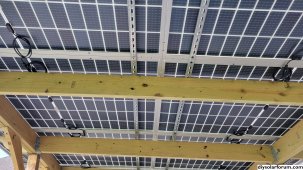stuffnjunk
New Member
Background: Doing my due diligence on a ground array grid tie in setup with battery backup (for emergency loads). This ground array would be about a meter off the ground using bifacial panels. I am in the northern U.S. on a hilltop, and we do get snow. I have several acres I can place these panels on that do not get any shading at all as I mainly have an empty field.
IF someone can answer this by providing a clear link I would appreciate it. I'm not sure I completely understand the difference between the two, as most articles I have read are only discussing one sided panels, or roof top mounts. Are micro inverters mainly for panels that get shade from trees, or are they talking about an array that gets partial shading from passing clouds, or is it all shading? With the half cut bifacial panels I don't understand what the benefit is to using them vs. a string. Other than making different panel layouts? I am only seeing it as more ways to block sunlight on the backside of the bifacial panel (more boxes). So if I use a string I have to use optimizers? This adds more boxes that could potentially block the backside of the panel. What doesn't make sense to me with the optimizer is that with bifacial panels, the front and the back should never be the same, and I don't think an array would have identical panels through the whole array as that array would partially block some of the Irradiance? throughout the entire array (depending on layout). I probably just don't understand this well enough to wrap my head around it.
I know there are a lot of other issues, but I am trying to work out an issue or two at a time then do more reading. To make matters worse I did read about sodium batteries and perovskite panels.
IF someone can answer this by providing a clear link I would appreciate it. I'm not sure I completely understand the difference between the two, as most articles I have read are only discussing one sided panels, or roof top mounts. Are micro inverters mainly for panels that get shade from trees, or are they talking about an array that gets partial shading from passing clouds, or is it all shading? With the half cut bifacial panels I don't understand what the benefit is to using them vs. a string. Other than making different panel layouts? I am only seeing it as more ways to block sunlight on the backside of the bifacial panel (more boxes). So if I use a string I have to use optimizers? This adds more boxes that could potentially block the backside of the panel. What doesn't make sense to me with the optimizer is that with bifacial panels, the front and the back should never be the same, and I don't think an array would have identical panels through the whole array as that array would partially block some of the Irradiance? throughout the entire array (depending on layout). I probably just don't understand this well enough to wrap my head around it.
I know there are a lot of other issues, but I am trying to work out an issue or two at a time then do more reading. To make matters worse I did read about sodium batteries and perovskite panels.




